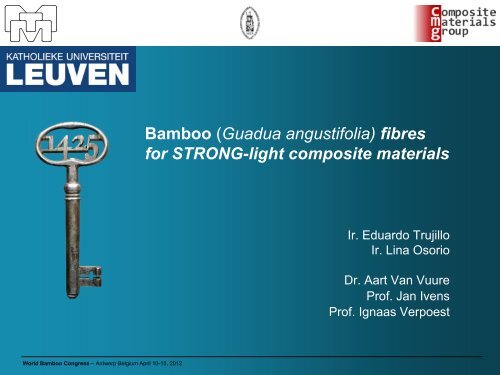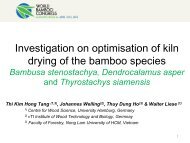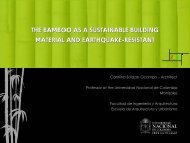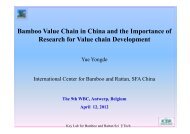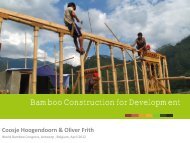Trujillo, Eduardo - World Bamboo
Trujillo, Eduardo - World Bamboo
Trujillo, Eduardo - World Bamboo
Create successful ePaper yourself
Turn your PDF publications into a flip-book with our unique Google optimized e-Paper software.
<strong>World</strong> <strong>Bamboo</strong> Congress – Antwerp Belgium April 10-15, 2012<br />
<strong>Bamboo</strong> (Guadua angustifolia) fibres<br />
for STRONG-light composite materials<br />
Ir. <strong>Eduardo</strong> <strong>Trujillo</strong><br />
Ir. Lina Osorio<br />
Dr. Aart Van Vuure<br />
Prof. Jan Ivens<br />
Prof. Ignaas Verpoest
<strong>Bamboo</strong> fibres<br />
<strong>Bamboo</strong> fibre<br />
composites<br />
The future<br />
Conclusions<br />
Content<br />
• Extraction<br />
• Properties<br />
• Discontinuity of the fibre<br />
• Properties<br />
• Applications<br />
• Pros and cons<br />
<strong>World</strong> <strong>Bamboo</strong> Congress – Antwerp Belgium April 10-15, 2012 2
<strong>Bamboo</strong> fibres<br />
<strong>Bamboo</strong> fibre<br />
composites<br />
The future<br />
Conclusions<br />
Content<br />
• Extraction<br />
• Properties<br />
• Discontinuity of the fibre<br />
• Properties<br />
• Applications<br />
• Pros and cons<br />
<strong>World</strong> <strong>Bamboo</strong> Congress – Antwerp Belgium April 10-15, 2012 2
Why bamboo?<br />
• Fast growing<br />
•Natural growing<br />
plant<br />
•Environmental benefits<br />
1 hectare of bamboo sequesters 62<br />
tons of CO2/year 1 hectar of young forest sequesters 15<br />
tons CO2/year J.Jansen, Technical Univ. Eindhoven, 2000<br />
•Specie Guadua<br />
angustifolia<br />
21 cm/day<br />
Resource<br />
Final height in 6 months<br />
Maturity in 4-6 years<br />
Enormous capacity of<br />
renovation without reseed<br />
Prevention of the erosion<br />
Increases the organic<br />
material in the soil<br />
Capture CO 2<br />
<strong>World</strong> <strong>Bamboo</strong> Congress – Antwerp Belgium April 10-15, 2012 3<br />
One of the largest bamboo<br />
species on the world<br />
Large size – Good<br />
properties
<strong>Bamboo</strong> fibre extraction process<br />
Extraction methods for bamboo fibres<br />
• Steam explosion High pressure and T° (several times)<br />
• Chemical extraction NaOH (high concentrations)<br />
• Combination of chemical and mechanical<br />
• Mechanical extraction<br />
<strong>Bamboo</strong> fibre without<br />
extraction process<br />
K.U.Leuven<br />
<strong>World</strong> <strong>Bamboo</strong> Congress – Antwerp Belgium April 10-15, 2012 4<br />
Primary fibre
Strength (MPa)<br />
850<br />
750<br />
650<br />
550<br />
450<br />
350<br />
250<br />
150<br />
<strong>Bamboo</strong> fibre extraction process<br />
Strength comparison between different bamboo<br />
fibre extraction techniques<br />
Chemical extraction<br />
Mechanical<br />
(rolling mill machine)<br />
Steam<br />
explosion<br />
0 100 200 300 400 500 600<br />
Extraction method<br />
Mechanical process<br />
(in some cases chemical<br />
process is required)<br />
<strong>World</strong> <strong>Bamboo</strong> Congress – Antwerp Belgium April 10-15, 2012 5<br />
K.U.Leuven<br />
process<br />
Grip<br />
Tensile test<br />
• No chemicals are used<br />
• Room temperature<br />
<strong>Bamboo</strong><br />
fibre<br />
New extraction process:<br />
• Not previous preparation of the<br />
raw material (e.g. retting)<br />
• Continuous process
<strong>Bamboo</strong> fibre extraction process<br />
Stiffness comparison between different bamboo<br />
fibre extraction techniques<br />
<strong>World</strong> <strong>Bamboo</strong> Congress – Antwerp Belgium April 10-15, 2012 6<br />
Grip<br />
Tensile test<br />
<strong>Bamboo</strong><br />
fibre
<strong>Bamboo</strong> fibre extraction process<br />
<strong>Bamboo</strong> fibres<br />
<strong>Bamboo</strong> Industry Development Co., (2011)<br />
<strong>Bamboo</strong> fibre technology group (2011)<br />
from different sources<br />
Industry Scientific papers<br />
Hiroyuki Kinoshita et al, 2009 S. Shibata et al, 2008<br />
Keiji Ogawa et al, 2008<br />
R. Rowell 2008<br />
10 mm<br />
<strong>World</strong> <strong>Bamboo</strong> Congress – Antwerp Belgium April 10-15, 2012 7<br />
O. Yamashita et al, 2007<br />
0.5 mm<br />
KU Leuven fibres<br />
5 mm<br />
Kazuya Okubo et al, 2004
Fibre<br />
Growing<br />
cycle<br />
(days)<br />
Biomass waste<br />
(Ton) to produce<br />
1 Ton of fibre<br />
Fibre yield<br />
(kg/hectare)<br />
Flax 85-120 - 1100*<br />
Sisal Continuous 25*<br />
3360*<br />
600-1200**<br />
Ramie 45-60 - 550*<br />
Jute 120-150 20*<br />
2200*<br />
1600-2000**<br />
Kenaf 150-180 -<br />
1700*<br />
2300**<br />
Hemp 130-180 - 1225*<br />
Cotton 180-200 - 790*<br />
Abaca Continuous 48* 3000*<br />
500-1000**<br />
Henequen - 1500*<br />
<strong>Bamboo</strong><br />
(G. angust.)<br />
Continuous ~11 - 14 ~1045 - 3120<br />
Source:<br />
Fibre yield after extraction<br />
* R. M Rowell, (2008)<br />
* * Wallenberger, F. And Weston, N., (2004)<br />
<strong>Bamboo</strong> fibre extraction process<br />
<strong>World</strong> <strong>Bamboo</strong> Congress – Antwerp Belgium April 10-15, 2012 8<br />
6
Why bamboo fibres?<br />
Stress (MPa)<br />
1200<br />
1000<br />
800<br />
600<br />
400<br />
200<br />
0<br />
<strong>Bamboo</strong> fibres show some<br />
similarities with glass fibres<br />
Typical Stress - Strain curve<br />
for single bamboo fibre<br />
Strain (%)<br />
Fibre properties<br />
<strong>World</strong> <strong>Bamboo</strong> Congress – Antwerp Belgium April 10-15, 2012 9<br />
• The same linear elastic behaviour under<br />
tensile load<br />
• Brittle fibres (strain ~ 2%)<br />
• Specific properties are comparable with<br />
glass fibre<br />
Density Glass fibre: 2.5 (g/cm3)<br />
Density bamboo fibre: 1.4 (g/cm3)<br />
(<br />
Roughness of the bamboo fibre (Veeco profilometer)<br />
σ<br />
ρ<br />
,<br />
E<br />
ρ<br />
)
Weibull distribution<br />
Fibre properties<br />
“m” value = 8.3<br />
Fibre “m” Reference<br />
Jute 6 Shaha, et al 2011<br />
Jute<br />
Coir<br />
3-4<br />
9-3<br />
Defroid,et al 2010<br />
Span length:<br />
15mm - 35mm<br />
Flax 3 - 4 Baillie, et al 2007<br />
Jute 2-1 Xia, et al, 2009<br />
Span length:<br />
5mm- 20mm<br />
Shape factor (m) � indicator of the variation in the data: the bigger the value the smaller<br />
the variation in the data.<br />
Manmade fibres usually 5 and 15,<br />
Natural fibres (larger variation in their properties) between 1 and 6<br />
<strong>World</strong> <strong>Bamboo</strong> Congress – Antwerp Belgium April 10-15, 2012 10<br />
(Baillie, 2007).
Fibre bundle test<br />
Fibre bundle test<br />
Strain measurement<br />
Fibre properties<br />
Failure of the bundle<br />
<strong>World</strong> <strong>Bamboo</strong> Congress – Antwerp Belgium April 10-15, 2012 11<br />
Shape parameter<br />
(m)<br />
1 cm width<br />
Failure bundle tensile results<br />
σ f<br />
(MPa)<br />
4 cm span length<br />
E<br />
(GPa)<br />
5.7 640±45 49±11
<strong>Bamboo</strong> fibres<br />
<strong>Bamboo</strong> fibre<br />
composites<br />
The future<br />
Conclusions<br />
Content<br />
• Extraction<br />
• Properties<br />
• Discontinuity of the fibre<br />
• Properties<br />
• Applications<br />
• Pros and cons<br />
<strong>World</strong> <strong>Bamboo</strong> Congress – Antwerp Belgium April 10-15, 2012 12
<strong>Bamboo</strong> fibres Curing time<br />
Reinforcement<br />
Resin Hardener<br />
Matrix<br />
<strong>Bamboo</strong> fibre composites<br />
Unidirectional<br />
disposition of<br />
the fibres<br />
(UD)<br />
+<br />
Force<br />
<strong>World</strong> <strong>Bamboo</strong> Congress – Antwerp Belgium April 10-15, 2012 13<br />
=<br />
<strong>Bamboo</strong> fibre / epoxy composite
Discontinuity of the fibre<br />
Continuous UD<br />
prepreg<br />
<strong>Bamboo</strong> fibre composites<br />
Node<br />
Internode<br />
Continuous and discontinuos UD prepreg<br />
Discontinuous UD<br />
prepreg<br />
<strong>World</strong> <strong>Bamboo</strong> Congress – Antwerp Belgium April 10-15, 2012 14<br />
Discontinuity of the fibre<br />
Walter Liese<br />
1998<br />
UD bamboo fibre - TP tape<br />
Length of<br />
internodes<br />
(± 25 cm)
Unidirectional discontinuous BF/epoxy composites<br />
Fibre patterns<br />
<strong>World</strong> <strong>Bamboo</strong> Congress – Antwerp Belgium April 10-15, 2012 15
Unidirectional discontinuous BF/epoxy composites<br />
Experimental results: Tensile stifness<br />
<strong>World</strong> <strong>Bamboo</strong> Congress – Antwerp Belgium April 10-15, 2012 16<br />
bundles<br />
Efficiency factor:<br />
92% ± 6
Unidirectional discontinuous BF/epoxy composites<br />
Experimental results: Tensile strength<br />
bundles<br />
Good agreement with “The local load sharing (LLS) model”<br />
<strong>World</strong> <strong>Bamboo</strong> Congress – Antwerp Belgium April 10-15, 2012 17<br />
Efficiency factor:<br />
79% ± 4
Unidirectional discontinuous BF/epoxy composites<br />
Experimental results: Flexural strength<br />
Flexural strength (MPa)<br />
Flexural stiffness (GPa)<br />
Natural fibres composites<br />
Thermoset matrix<br />
Flexural strength<br />
1 2 3 4 5 6 7 8 9 10 11<br />
1 2 3<br />
Natural fibres composites<br />
Thermoset matrix<br />
Flexural stiffness<br />
4 5 6 7 8 9 10<br />
<strong>World</strong> <strong>Bamboo</strong> Congress – Antwerp Belgium April 10-15, 2012 18<br />
1. <strong>Bamboo</strong> (G. ang.) + Epoxy (Vf: 40%)<br />
2. Flax + Epoxy (Vf: 40%)<br />
3. Jute + Epoxy (Vf: 40%)<br />
4. Jute + Vinylester (Vf: 35%)<br />
5. Hemp + Epoxy (Vf: 35%)<br />
6. Sisal + Epoxy (Vf: 37%)<br />
7. Kenaf + Cashew nut Shell (Vf: 64%)<br />
8. <strong>Bamboo</strong> + Polyester (Vf: 15%)<br />
9. Kenaf + Polyester (Vf: 60%)<br />
10. Hemp + Polyester (Vf: 60%)<br />
11. Hemp + Cashew nut Shell (Vf: 65%)<br />
1. <strong>Bamboo</strong> (G. ang.) + Epoxy (Vf: 40)<br />
2. Flax + Epoxy (Vf: 40%)<br />
3. Jute + Epoxy (Vf: 40%)<br />
4. Jute + Vinylester (Vf: 35%)<br />
5. Hemp + Epoxy (Vf: 35%)<br />
6. Sisal + Epoxy (Vf: 37%)<br />
7. Kenaf + Cashew nut Shell (Vf: 64%)<br />
8. Kenaf + Polyester² (Vf: 60%)<br />
9. Hemp + Polyester (Vf: 60%)<br />
10. Hemp + Cashew nut Shell (Vf: 65%)<br />
Force<br />
3 point bending test<br />
. . .<br />
. .<br />
.<br />
.<br />
.
<strong>Bamboo</strong> fibres<br />
<strong>Bamboo</strong> fibre<br />
composites<br />
The future<br />
Conclusions<br />
Content<br />
• Extraction<br />
• Properties<br />
• Discontinuity of the fibre<br />
• Properties<br />
• Applications<br />
• Pros and cons<br />
<strong>World</strong> <strong>Bamboo</strong> Congress – Antwerp Belgium April 10-15, 2012 19
Applications<br />
Continuous<br />
tape<br />
Continuous “tape” of aligned bamboo fibres to make composite materials<br />
This “tape” is<br />
currently used in<br />
composites<br />
industry<br />
Glass fibre Carbon fibre<br />
<strong>World</strong> <strong>Bamboo</strong> Congress – Antwerp Belgium April 10-15, 2012 20
Continuous<br />
“Tape”<br />
Further Hi- Tech<br />
applications<br />
• Broader range of applications<br />
• High adaptability to existing<br />
composites technologies<br />
• Green choice<br />
Semi-esructural<br />
composites market<br />
Applications<br />
<strong>World</strong> <strong>Bamboo</strong> Congress – Antwerp Belgium April 10-15, 2012 21<br />
Picture: http://www.ircomas.org<br />
Picture: http://www.ircomas.org<br />
Picture: JEC - 2011<br />
Fotobron: http://www.lineo.eu/
Lighter cars … reduce energy consumption!<br />
Sorce: KULeuven: De Moor Jozef, 2008<br />
Applications<br />
<strong>World</strong> <strong>Bamboo</strong> Congress – Antwerp Belgium April 10-15, 2012 22<br />
In all moving applications, the<br />
energy consumption<br />
is + proportional to the<br />
mass…<br />
… hence mass reduction<br />
is needed !!!
The 4 phases in the life of a product and their relative importance<br />
In the total life cycle, these 4 aspects have a different impact,<br />
depending on the application area<br />
In “moving”<br />
Applications<br />
Source: Ashby, M. et al. Materials engineering, science, processing and design (2007)<br />
applications the use<br />
<strong>World</strong> <strong>Bamboo</strong> Congress – Antwerp Belgium April 10-15, 2012 23<br />
efficiency is most important
Energy content of natural fibres<br />
140<br />
120<br />
100<br />
80<br />
60<br />
40<br />
20<br />
0<br />
lignocellulosic<br />
fibres<br />
mat<br />
Applications<br />
energy ( MJ/kg)<br />
mat<br />
glass fibre carbon fibre<br />
Hemp can store about 0.75 kg of CO 2<br />
energy ( MJ/kg)<br />
per kg of fibres during growth<br />
Hemp releases 10 MJ/kg upon incineration (with energy recovery)<br />
<strong>World</strong> <strong>Bamboo</strong> Congress – Antwerp Belgium April 10-15, 2012 24
Moisture absorption<br />
170°C<br />
Disadvantages<br />
Thermal degradation (bamboo fibres)<br />
<strong>World</strong> <strong>Bamboo</strong> Congress – Antwerp Belgium April 10-15, 2012 25<br />
150°C
Conclusions<br />
Good mechanical properties for bamboo fibres were obtained by using a novel<br />
green mechanical extraction process<br />
Composites based on extracted long bamboo fibres and epoxy resin were<br />
successfully produced<br />
Performance in terms of strength and stiffness reach: 78% and 95% of the<br />
theoretical value (ROM)<br />
Future work: Research in progress - further technology development is<br />
required<br />
<strong>World</strong> <strong>Bamboo</strong> Congress – Antwerp Belgium April 10-15, 2012 26
<strong>World</strong> <strong>Bamboo</strong> Congress – Antwerp Belgium April 10-15, 2012 27<br />
Thank you!
Annexes
2.2 Results for single bamboo fibre tensile test<br />
Tensile strength (MPa)<br />
Tensile properties of single bamboo fibres<br />
1000<br />
900<br />
800<br />
700<br />
600<br />
500<br />
400<br />
300<br />
200<br />
100<br />
0<br />
2. Fibre properties<br />
5 10 25 40<br />
Gauge length (mm)<br />
Tensile strength Young´s modulus<br />
50<br />
45<br />
40<br />
35<br />
30<br />
25<br />
20<br />
15<br />
10<br />
5<br />
0<br />
Young´s modulus (GPa)
Comparison with other studies (bamboo fibres)<br />
Strength vs Modulus from some studies on bamboo technical fibres<br />
Grip<br />
Tensile test<br />
<strong>Bamboo</strong><br />
fibre
<strong>Bamboo</strong> fibre extraction process<br />
Fibre extraction<br />
• In line process (continuous)<br />
• No seasonal resource (“all<br />
year harvesting”)<br />
• High fibre extraction yield<br />
Competitive<br />
Price<br />
Target value
Ligth RTM<br />
Advantages:<br />
•Accurate determination of Vf<br />
• Control of the thickness<br />
• Two flat surfaces<br />
•Easy positioning (stacking) of the fibres<br />
Test and samples:<br />
• ASTM 3039 (tensile test)<br />
• Dimensions: Length: 26 cm, width: 2.5 cm, thickness: 1.8 mm<br />
• Vf: ~45%<br />
• 6 samples / pattern
170°C<br />
150°C


